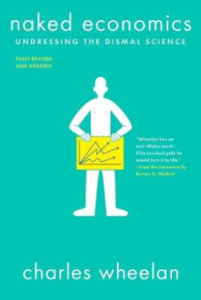Understanding macroeconomics – broad economic principles that apply to countries and governments – is deeply important for interpreting events that shape our increasingly interconnected world. For grasping big picture concepts about fiscal policy, economic growth, recessions and more, turn to these 3 illuminating macroeconomics books.
Don’t let the basics of macroeconomics intimidate you – Wheelan makes even dry topics lively with humor and real-world relevance. This book provides understanding of core principles in simple language on:
- How free markets interact with government policies
- Supply, demand and efficiency
- Measures of economic performance like GDP, inflation, unemployment
- Monetary policy – how central banks control money supply with interest rates to spur growth
- Fiscal policy – spending and taxes to moderate business cycles
- International trade and globalization
Wheelan connects the dots using relatable examples about gas taxes, the Federal Reserve setting rates and government responses to recessions. The book lives up to its “naked” title by stripping away complexity that can confuse macroeconomic newcomers. Highly readable from start to finish.
Already considered a modern economics classic, French economist Thomas Piketty’s tome focuses on the growing gap between the ultra wealthy and rest of society. He provocatively argues that without corrective measures, the future looks grim with even wider inequality as wealth accumulation may outpace economic growth.
Piketty deep-dives into hard data and warns that:
- When rate of return on capital exceeds economic growth over long periods in stable economies, wealth inequality swells astronomically.
- The gap worsens inequality more severely than factors like unequal wages or access to education.
- With richer people’s capital returns snowballing faster than national income growth, fortunes may regain 19th century “patrimonial capitalism” heights within this century.
Proposed solutions to close the divide include implementing a global progressive wealth tax and boosting financial transparency. Capital in the Twenty-First Century ignited fiery debates on inequality that still rage today.
Get an immersive, behind-closed-doors view into how leaders rescued the 2008 financial crisis. Sorkin’s 600-page page-turner plays out like a thriller. It dives deep into critical blow-by-blow decisions as investment megabanks crumbled under toxic subprime loans.
Heart-pounding drama depicts the desperate negotiations over 4 chaotic days to save giants like Lehman Brothers, Merrill Lynch, AIG and others from insolvency as credit evaporated. Top figures like Treasury Secretary Hank Paulson, Wall Street executives and Fed chairman Ben Bernanke tried engineering shotgun mergers to shield free-falling banks.
While the complex alphabet soup of TARP legislation and tranches of asset-backed bonds warrants a macroeconomics primer beforehand – the human stories of arrogance, panic, self-interest and frustration are utterly engrossing. Sorkin masterfully decodes how interconnected “too big to fail” Wall Street is with Main Street’s economic fate.
Bonus Macroeconomics Reads:
Can’t get enough of macroeconomics? Expand your perspective with these other stellar selections:
- Freakonomics by Stephen J. Dubner and Steven D. Levitt uses clever storytelling to reveal mindblowing connections, including how legal abortion lowered crime rates years later.
- Globalization and Its Discontents by Joseph E. Stiglitz gives insightful criticism on how orthodox free market and trade policies widened inequality in developing countries.
- Why Nations Fail: The Origins of Power, Prosperity and Poverty by Daron Acemoglu and James A. Robinson contrasts inclusive vs extractive institutions to explain wealth disparities between countries.
- The Shifts and The Shocks: What We’ve Learned—and Have Still to Learn—from the Financial Crisis by Martin Wolf analyzes underlying ruptures in the global economy, like China’s economic rise and trade imbalances, that fueled market volatility





